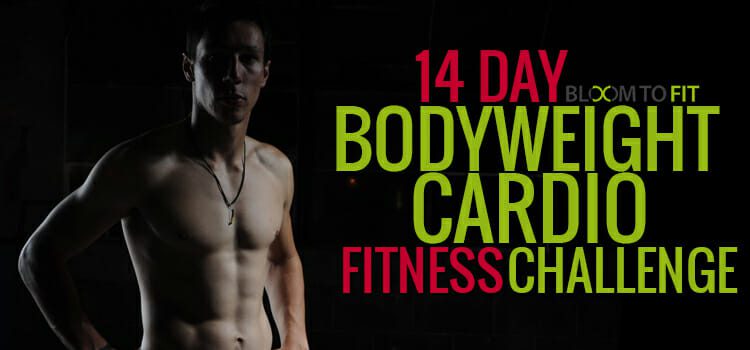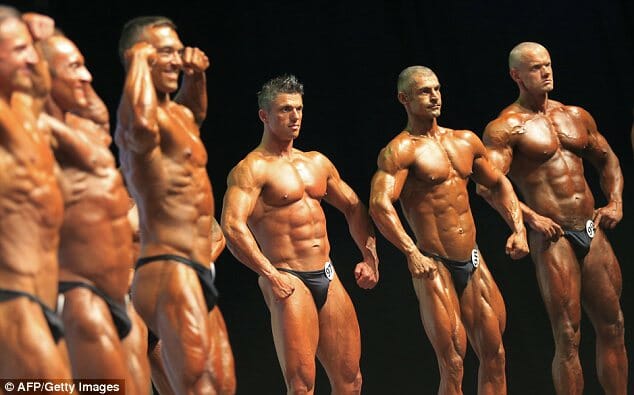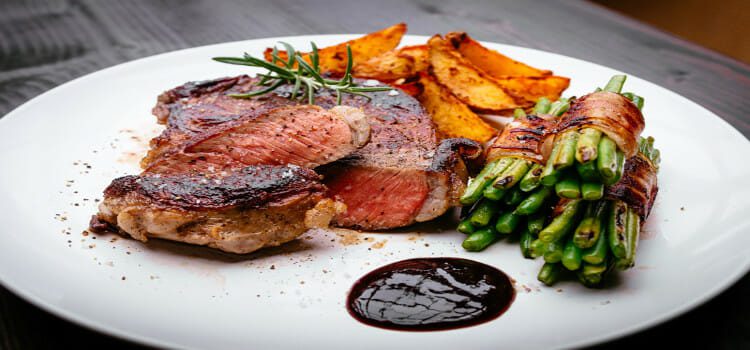IIFYM: Thanks for taking the time out to speak with IIFYM.comBrandan.
I know you are extremely popular in the bodybuilding and fitness world, but for those IIFYM.com readers that don’t recognize your name, would you please tell us a little bit about yourself and your position in the health and fitness industry?
BF: Well I do a lot of various things. I am a corporate wellness coordinator for the worlds largest ethanol company. I have a successful prep business called “Fokken Strong Training”, I have 13 sponsors
Bodybuilding.com, Beast Sports Nutrition, Quest, P28 foods, MuscleEgg to name a few. I am a physique competitor, fitness model, published writer, and I speak about health and fitness at universities and corporations around the country.
IIFYM: When did you first get involved in fitness and at what point did you realize that modeling was an option?
BF: I have been active my whole life and weight training since I was 14. I always wanted to be big and strong and that was it. I never even competed until I was 30! From there things spiraled for me and a lot of positive things started to happen. I actually did my first photo shoots as favors to some photographer friends of mine. I soon realized I could use those images to market myself and potential companies I wanted to work with.
I NEVER actually thought I would make it into any of the major fitness magazines. It wasn’t even a goal for me because I didn’t think it was possible. Slowly though I started to appear in ads in some of the smaller magazines and eventually worked my way up to all of the larger ones.
I have a lot of content waiting to be released and a lot of photo shoots already set up this year. I will say however that I do some fitness modeling from time to time; I am NOT a fitness model. I only consider someone who could make a living at it a legit fitness model. For me I do it because I enjoy it and its allowed me to do many things I never thought I would get the opportunity to do.
IIFYM: Posing for so many photo shoots, I am sure you need to stay leaner than most bodybuilders year round. I have seen some of your magazine spreads and you always look to be about 5-6% body fat or so sometimes leaner. Do you ever let yourself get out of shape, and if so, what would you consider “out of shape” to be?
BF: I actually do let myself go a bit. I take time off after what I call my “season” which is usually May-Nov to give myself a break. Maybe take some vacations, eat what I want and give my body some time off, but also time to really grow. I cut a lot of muscle when I compete, so the years I compete I like to especially have that time off to build back what I lost.
IIFYM: What about bodybuilding? Can you tell us a bit about your competitive career?
BF: I started my competitive career in bodybuilding as a light heavy weight. I then worked up to heavy weight and physique from there. Physique has been hugely successful for me and is far more marketable for me than bodybuilding ever would have been.
At 6’1 I was never going to be a 300 lb monster so the physique class suits me and my current goals, Although I will ALWAYS have a love for bodybuilding.
Contest history:
- 2010 Fargo Upper Midwest light heavy 3rd place
- 2010 Minneapolis Gopher State Classic 2010 light heavy 1st place
- 2011 Fargo Upper Midwest heavy weight 1st place
- 2011 Minneapolis Gopher State Classic Physique 2nd place
- 2011 NPC USA’s Physique tall class 16th out of 32
- 2011 Muscle and Fitness Gaspari Super Pump Challenge Online Winner
- 2011 Muscle and Fitness model contest “Olympia expo ” 4th out of 53
- 2011 Minnesota State North Star Physique mixed class 3rd overall
- 2011 Photo Vision model
- 2011 World Physique magazine competitor of the month and “promoting greatness” winner
- 2012 Bodybuilding.com Body Space Spokes model finalist
- 2012 Bodybuilding.com Body Space spokes model contest LA expo 5th place
- 2012 Muscle and Fitness Online Winner *First two time winner*
- 2012 Bodybuilding.com “Amateur of the Week July 2012”
- 2012 Bodybuilding.com 2012 “Top 20 Extreme Physiques”
- 2012 Bodybuilding.com 2012 “Top 20 Extreme Physiques Part Two”
- 2012 Muscle and Fitness model contest “Olympia expo” 6th out of 64
- 2013 Muscle and Fitness Online Winner *First three time winner*
- 2013 Muscle and Fitness model contest “Olympia expo” 2nd out of 70
- 2013 Minnesota State North Star 2nd
- 2013 Oregon Seven Feathers 2nd
- 2013 NIKE promo model/athlete
Have also won many online titles not listed above.
IIFYM: Why men’s physique instead of bodybuilding? I’ve seen you in person and you are jacked!!
BF: I actually did my first physique show two weeks after winning my class at heavyweight at the Upper Midwest in Fargo. I tore a muscle in my quad and my leg swelled all up and it looked really bad. That was at the same time physique had come out.
I was going to do that second show after Fargo, but knew that my leg looked like hell. So my coach suggested physique. I initially didn’t want to do it and thought I would get made fun of, but ended up giving in and tried it anyways.
I essentially went zero carbs for two weeks and lots of cardio to try and bring my size down. I never carbed up or pumped up as to not look too big. I ended up taking 2nd behind my friend Trevor Larsen who is now a pro. From there I was hooked.
IIFYM: What do you feel is your most lagging body part and what are you doing to turn it into an asset?
BF: My legs. Yea you can say what you want about physique guys not having legs. Are mine perfect? No… But I’m not ashamed of myself. I train hard in all that I do, but my legs are def something I would really like to bring up.
That’s one body part that when you have a jacked set of wheels people take notice, not many can say they do. I have started training them twice a week and its paid off so far.
IIFYM: Can you give the IIFYM diet community a taste of what your contest prep diet is? What are your macros and what kinds of foods do you eat?
My diet is pretty simple. I used to measure every single thing to the ounce but this last prep I really let loose and eyeball measured everything. I changed my proteins when I wanted, at a lot of beef and had weekly cheat meals.
I kept those mostly cleaner cheats, meaning I didn’t gorge myself on fast food etc. My body reacts well to fats so I usually will implement a lot of fat into a cheat/treat meal.
Meal 1 7-730
1 cup MuscleEgg Whites
½-3/4 cup my
oatmeal flavored oats
Meal 2 10-1030
0.75 cup Brown Rice – cooked
6-8 ounce(s) lean protein
Meal 3 1230-130
1 cup Broccoli
6-7 ounce(s) lean protein
6 ounce(s) sweet potato
Meal 4 3-330
1 tablespoon P28 almond butter
2 scoops Beast Whey protein
Periodically I will have a P28 bagel
Meal 5 630-730
4-6 oz. sweet potato
15 almonds
1 cup greens
6-8 ounce(s) lean protein- periodically I have a 8 oz sirloin
Meal 6 930-10
1 tablespoon P28 almond butter
1 cup MuscleEgg
Once a week I will have a “cheat meal”. Off season it can be about anything, on season I eat 3 quest nutrition bars and 4-6 tablespoons of P28 almond butter.
IIFYM: From what you know about IIFYM, what do you think are the strong points and what are the flaws?
BF: I think a lot of people don’t have the dedication to count all their macros day in and day out. For me I’m busy and I like to have something a bit more regimented in my on season. However I think that both ways work. You just have to be educated in what you are doing.
My fiancé follows IIFYM and I don’t, but yet again I do because I have my base diet set up and from there I’m not afraid to substitute out foods in place of what’s on my plan.
IIFYM: I know that you have a consulting business where you help top-level bodybuilding competitors get in shape for the stage. I have seen some of your clients and I have to say that I am very impressed. I know that you don’t follow an IIFYM approach to nutrition and contest prep, but I am sure our readers would still love to hear more about your philosophy.
BF: Well I like to build their metabolic capacity to start things off. All too often someone comes to me and they’ve been eating absolutely nothing and doing hours of cardio etc. I like to work with people longer than the norm “12 weeks” and really take the time to make sure they aren’t going into a show eating 800 cals etc and still burning no body fat.
So we start with that and when we get them up to a reasonable level we then will slowly add in some cardio and slowly take down their calories as they progress, but only if necessary. When you have enough time a person’s body will essentially get used to more calories and get leaner in the process, unfortunately a lot of coaches never give their clients a fighting chance and just cut everything out.
I always implement a cheat meal each week. Some people again don’t agree with that, but I think for what I do and the methods I use it does and has worked great for my clients. Post show I help them out of “prep” and help reverse diet them out of the show.
I also REALLY believe in the mental aspect of things. So with that I have a private team page all of my athletes can interact on and can encourage one another.
My team is more of a family and I don’t just take everyone on for the purpose of making a buck.
I want hard working people that are ready to work, but also good people that respect others and support others in their quest to betterment. My team members are all very unique but also at the root of things very much the same so it all works great.
I am never unavailable to clients and have a support system of assistants below me that they can also contact if at that very moment I am unavailable. Essentially when I take someone on, Its all-encompassing. I do everything I can to help them be successful on stage, but also in life.
IIFYM: Are there any clients that you are particularly proud of that you would like to mention? Anyone, that has beaten the odds or overcome an amazing struggle?
BF: I love all my clients. I will however name a few.
- Ashley Kurtenbach
- Kay Jordt
- Nikki Walter
- Tera Busker
With a large team its hard to name everyone, but these ladies have all pushed through many life events to gain success and become the strong ladies they are today.
As one of your Facebook friends I see your daily updates and I have to tell you man, I am impressed with how encouraging you are. You always bring a very humble, forgiving and positive sense of self to your followers while encouraging us to do the same.
IIFYM: Can you give our IIFYM readers some insight into your belief system? Maybe a few tools we can implement to move towards a more positive version of ourselves?
BF: I can’t just give one tip. I think a lot goes into this lifestyle and you have to have a lot of things in order to be successful.
You need to first of all be ok with yourself in whatever you are involved in, or what level you are at in everything you do “workout routine, diet, etc.” When you are ok with yourself and love yourself, you will make more of a commitment to the betterment of you. You also won’t get discouraged when things don’t go exactly how you want them to. You will have the strength to carry on and continue to try to achieve the results you are striving for.
If you don’t love yourself now and every step of the way, you definitely won’t be happy wherever it is you are going.
Everything takes time; it took time to put on the weight so it will take time to take it off. Set some realistic goals and then set a big goal at the end. Enjoy each incremental goal that you have achieved on the way to your big goal and celebrate those victories on the way to a better you.
If you are having a hard time with the plan you are on, take a step back and reevaluate what you are doing and make sure the plan is right for you. Make sure your diet and workout routine fits in accordance with your goals, diet being the most important.
If you’re not eating for results you will never have the success you want. Also change up your plan. Your body adjusts to workouts etc rather quickly, so if you are always doing the same stuff your body won’t make the changes you want it to.
Surround yourself with positive people and people that help you along the way. Negative people will just bring you down and make it that much harder for you to achieve your goals.
The people that bring you down are afraid of change, and feel that you’re positive attitude and hard work somehow makes them have to make those changes too, which scares people, so they will become your worst critics.
Rise above that and work on you, you are the best investment you can make. Also be open to advice. Ask questions and absorb what others pass on to you. However don’t make this information “truth” as many gurus out there believe they know it all and will pass on bad advice every chance they get. Do your homework and investigate the advice you are given and find which advice best works for you.
Use the resources you have and educate yourself,
Bodybuilding.com being a major one. Make sure you are doing a routine that is right for you and you have a good diet plan in place too, nutrition is 80% of the equation. If that doesn’t work, consider hiring a trainer.
Don’t try to be just like someone else – that’s a recipe for failure. It’s ok to look up to, learn from, and be inspired by others, but don’t put yourself below them and assume they are better than you, be you and proud of your own accomplishments. The people you admire were once not so different than you. Blaze your own trail! You can accomplish anything you want with a strong mind, strong goals, and hard work. So if you want something, go get it.
IIFYM: How about sponsors? Are there any sponsors you would like to mention? Any companies you think our IIFYM readers should check out?
BF: All of my sponsors of course
IIFYM: Now I’d like to move on to the part of the interview we call Rapid Fire IIFYM.
When you agreed to this interview, I asked the IIFYM facebook group for some questions they might have for you. Feel free to answer these with short answers:
What does your shoulder routine consist of?
BF: Lol the shoulder questions…I get this one A LOT I like to train my shoulders with higher reps and LOTS of angles.
- Dumbbell Lateral Raises: 4 sets 15,15,12,10
- Smith Machine or seated db Shoulder Presses: 5 sets 15,12,10,10,10
- Standing straight curl bar side raises: 4 sets 15,15,15,15
- Dumbbell front Raises: 3 sets 15,12,10
- Barbell Shrugs: 5 sets 20,20,15,12,10
- Upright rows: 4 sets 15,12,12,10
- Seated rear delt machine, cables, or dumbbells: 4 sets 15,12,12,10
- Angled side raise with db to the side: 4 sets 12,12,12,10
Did you ever struggle with your weight?
BF: Of course…I don’t care who you are, nobody is perfect. I’ll tell you the first time you see yourself in photo-shoot or stage condition it’s hard to be anything less than that. When I was younger I was just happy being big, but now its hard to see myself sometimes anything less than stage ready.
In my off season when I add weight its one of the hardest things for me to do and see. Over time though I grow to accept how I look and when I fully accept it I know I’m ready to go at it again. I’ve fallen in that self-loathing and feeling terrible about myself and even bouts of body dysmorphia because I didn’t think I looked good, but even in off season I probably am leaner than 90% of the people at the gym.
Essentially if you don’t love yourself at EVERY step of the way, you’ll never love yourself where you are going and NEVER be happy. So that’s another reason for me taking time off. Letting myself KNOW I don’t need to be perfect.
What supplements do you believe in?
I wouldn’t be where I am at today without supplementing my diet. There are a lot of products on the market, and some great ones, but for myself I recommend Beast Sport Nutrition supplements, their entire line is GREAT!
They are also priced right and offer a lot of knowledge/science that backs up what they sell. If I were to recommend any other company for products Beast doesn’t offer, I would recommend looking at and reading the reviews on
Bodybuilding.com and go through them for your nutritional needs. You can also purchase Beast products through
Bodybuidling.com, so you get the best of both worlds.
- Beast Mode pre workout
- Creature pre workout
- Multi core with breakfast #1
- Omega 3 with breakfast and last meal #1, #6
- Glutamine post workout 5g
- 2 Shredded or Amphetalean both by Beast*when dieting* upon waking and mid-day #1, #4
- Beast Whey post workout- before bed #6
- Aminolytes by Beast Sports – intra workout and post
- L-Carnitine with breakfast and pre workout
- ALA with breakfast and lunch #1, # 3
- Vitamin D3 with breakfast #1
- Baby aspirin
- Mangnesium breakfast #1
- B complex breakfast #1
- Vitamin C breakfast #1
- Adrenal Support breakfast #1
I have tried pretty much EVERYTHING out there. I’m not about gimmicks and the promise of quick results. The supplements I take I believe to help me recover and give me that edge I need in training as hard as I do.
I have had great results with my supplement regimen and feel it works best for me. I think when you push yourself as hard as I do or any competitor for that matter having that extra boost that supplements offer keep you healthy, and help you recover to keep you moving forward.
We restrict our diets when we diet down, so making sure to fill those gaps, which that’s what supplements are meant for, NOT to take the place but to add to a nutrition plan, helps me to reach my goals while always striving for new ones.
How much cardio do you do when dieting?
BF: 20 mins on a stepper and then in the summer I like to walk outside, I do that almost every day.
HIIT or LISS?
BF: LISS
When was the last time you ate fast food? What was it?
BF: I had two cheese roll-ups from Taco Bell after the LA expo…I think I cried a little bit. Sometimes the most simple of things are the best lol
What is your ideal cheat meal?
BF: I don’t ever have cravings, but on season I normally stick to quest bars and peanut butter. Or I have a burger and sweet potato fries. I’m NOT a picky eater and love all food as long as I’m eating
Are you married?
BF: No but I will be June 28th of this year to my fiancé Amber Dawn Orton
Do you dehydrate for a show or do you increase water to flush water?
BF: I have done both, but find that having water in my system works FAR FAR better when done right. I also do the same for my clients.
IIFYM: If there is anything you would like to tell the IIFYM community, now is the time!!
BF: I think you have a great site and a great attitude. I also think that having methods like IIFYM is a great way to get more people interested in health, nutrition, and fitness and am impressed with the knowledge that so many people display online or your site day to day.
I also am a fan of a community that takes the time to help others and educate them, so to me you guys are doing it all right!





